All of It
 |
Contents |
For electromagnetism all you need to know is what happens when you have + or – charges, what happens when they get close and what happens when they move. That’s it! For all of non-quantum EM there are only 5 formulas you need. The 4 Maxwell Equations and the Lorentz equation describe all of electricity, magnetism, light, sound, radiation, actually most of physics:
(1) ![]()
(2) ![]()
(3) ![]()
(4) ![]()
(5) ![]()
How bad can a topic be if you can describe it all with just 5 equations, you could probably fit them all on the back of a beermat. Now that you’ve seen the conclusion we can go to the beginning and read the whole story in detail. Unless you’re doing a university course you can get away with not knowing exactly what the equation mean or do, but this site will explain them later, first lets get back to basics.
The Basics
Charge comes in 2 types, positive and negative and is measured in Coulombs (C). If you have a charge on its own it emits a field in all directions. The field from a charge is represented by E as in E-lectricity. If you put another charge in the field it experiences a force. Like charges repel and unlike charges attract. The bigger the charge the stronger the force and the further away the charges the weaker the force, exactly what you’d expect. This relationship can be represented by Coulombs Law;
![]()
and
![]()
The ![]() ‘s are the two charges and
‘s are the two charges and ![]() is the distance between them squared. The other bit is just a constant which roughly equals 9000000000. (The exact derivation of this law can be found here). From these you can see that the force is just the field times by whatever charge you put in,
is the distance between them squared. The other bit is just a constant which roughly equals 9000000000. (The exact derivation of this law can be found here). From these you can see that the force is just the field times by whatever charge you put in, ![]() . Using this you can work out the field or force between particles or atoms or anything with charge provided they’re not moving. Once you start a charge moving other things happen.
. Using this you can work out the field or force between particles or atoms or anything with charge provided they’re not moving. Once you start a charge moving other things happen.
Stuff Moving
As soon as a charge starts to move it produces another field. The new field is magnetism and is represented by B as in B-magmatism?
The reason it’s B is simply that it was the second thing in an alphabetical list:
- Electromagnetic vector potential: A
- Magnetic induction: B
- Total electric current: C
- Electric displacement: D
- Electromotive force: E
- Mechanical force: F
- Velocity at a point: G
- Magnetic intensity: H
(This also explains where H comes from for those interested).
So now your particle or atom or whatever has 2 fields coming out. The full equation to describe how both fields act on a particle is
![]()
which is known as the Lorentz force. The ![]() symbol does not signify multiplication, in this context it means Cross-Product. It’s basically a short way of writing “
symbol does not signify multiplication, in this context it means Cross-Product. It’s basically a short way of writing “![]() times
times ![]() times the sine of the angle between”. This is because the
times the sine of the angle between”. This is because the ![]() field pushes at 90° to which ever direction its pointing AND which ever direction you are moving in. Now unless you’re doing EM past A-level you can forget all about the directions and angles and just write
field pushes at 90° to which ever direction its pointing AND which ever direction you are moving in. Now unless you’re doing EM past A-level you can forget all about the directions and angles and just write
![]()
If we expand out the above expression we have
![]()
But we can already describe one of these bits, ![]() is just Coulombs Law. Also, at A-level or below the situation will probably be simplified so you only have to consider the
is just Coulombs Law. Also, at A-level or below the situation will probably be simplified so you only have to consider the ![]() and
and ![]() fields separately. So you will probably only have to use one of the following two formulas,
fields separately. So you will probably only have to use one of the following two formulas,
![]()
![]()
Obviously ![]() is the force and
is the force and ![]() is charge,
is charge, ![]() and
and ![]() are the two fields previously described and
are the two fields previously described and ![]() is the velocity of the moving charge. The electric field is measured in the SI units of Newtons per coulomb (
is the velocity of the moving charge. The electric field is measured in the SI units of Newtons per coulomb (![]() ) or, equivalently, volts per meter (
) or, equivalently, volts per meter (![]() ). The magnetic field has the SI units of Teslas (T), equivalent to Webers per square meter (
). The magnetic field has the SI units of Teslas (T), equivalent to Webers per square meter (![]() ) or volt seconds per square meter (
) or volt seconds per square meter (![]() )
)
Circuits
Now I’m not a big fan of circuits, never have been, now hopefully I’ll be professional enough that my disliking of them won’t come across in this section but if it does I apologise in advance. If I really start to struggle with my hate I may have to call in a second writer
A circuits is basically just a series of moving charges with the occasional object or device in the way that affects the flow. Now when I say the electrons are moving around most people will think that their speeding around at close to the speed of light, but this is wrong. The actual electrons are moving EXTREMELY slowly, it’s the wave that travels fast. As stated above like charges repel, so put one electron next to another and they will move apart. With a current in a wire you basically have a tube of electrons and you’re adding one to one of the ends, this causes the next electron to move down which in turn pushed the next one and so on. So you have a Mexican wave like effect that moves quickly, but the electrons themselves are only moving slowly.
Circuits usually contain all sorts of different objects and devices depending on what they’re for, and depending on how you set them all up in the circuit depends how you do all of you calculations.
Which is Which?
If you set up all your component in a closed loop like so
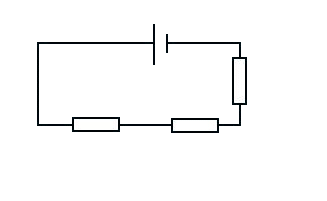
then we say that all the components are in Series. If you set them up with branching paths like so

then we say that the components are in Parallel. You can also make circuits that are a mixture of series and parallel section like so

Amps, Volts and Ohms (Oh my!)
We call the moving charges a Current, and it is measured in the SI unit of Amps (A). Amps are equivalent to the amount of charge passed in a certain time, so 2 coulombs in 6 seconds will be equivalent to 0.3A. This, like most things in physics can be expressed in a nice formula for you to learn
![]()
Another important idea in circuits is Voltage or Potential Difference. Volts are basically the difference in the Electric potential at two different points. The electric potential between 2 points is given as
![]()
where ![]() is the distance between
is the distance between ![]() and
and ![]() . It’s basically field times distance.
. It’s basically field times distance.
Another important idea when it comes to circuits is resistance. Resistance is basically a measure of how much resistance opposes an electric current. Almost all objects or devices in a circuit cause resistance and to calculating the total resistance in a circuit you use one or more of these rules
![]()
![]()
One of the most important and fundamental equations in circuits is Ohm’s law, and it relates current, voltage and resistance.
![]()
The Deep End
This is it. Classical EM goes no deeper than this. These 4 are the fundamental equation for ALL fields in EM. They may take a bit to get your head around but once you do it should all make sense, sort of.
![]()
![]()
![]()
![]()
If you don’t know about integration and differentiation I suggest you head over to the Integration section or the Differentiation section, I’ll try to explain it here but I’ll mainly be focusing on the physics.
Gauss’ Law
Ok then first up we have Gauss’ Law.
![]()
This says that the integral of the Electric field, ![]() , through a closed area
, through a closed area ![]() is equal to the total charge inside of the area,
is equal to the total charge inside of the area, ![]() divided by
divided by ![]() .
. ![]() is a constant called The Permittivity of Free Space and shows up all over physics along with
is a constant called The Permittivity of Free Space and shows up all over physics along with ![]() which is The Permeability of Free Space. What this equation means is you can take ANY closed surface you like and find the
which is The Permeability of Free Space. What this equation means is you can take ANY closed surface you like and find the ![]() field going through, provided you can do the maths. Usually you can’t. However there are a number of cases when its nice and easy. Cases when the
field going through, provided you can do the maths. Usually you can’t. However there are a number of cases when its nice and easy. Cases when the ![]() field is coming straight out through the surface evenly. The cases are
field is coming straight out through the surface evenly. The cases are
- A Spherical surface around a point or sphere
- A Cylindrical surface around an infinite wire
- A Regular surface over a section of an infinite plane
I admit these sound vague and abstract so I will demonstrate with the aid of a diagram.
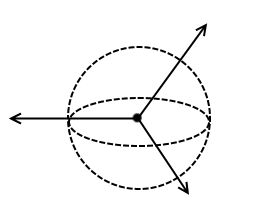
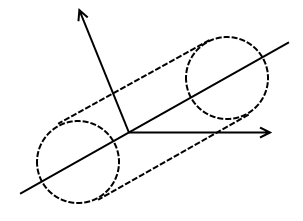
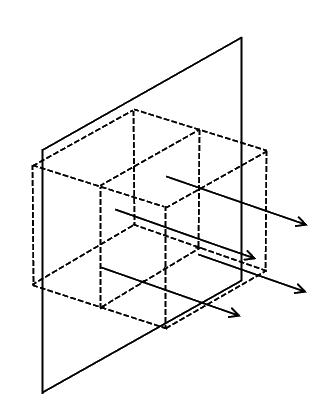
These are the Gaussian surfaces. Basically with these surfaces all you’re trying to do is make life easier. You just make sure that the surface is always the same distance from the charge source and that the field is always going through at 90 degrees. You can then work out the integral with your eyes closed its that easy. The left hand side of Gauss’ law becomes E times the surface of the shape you chose.
- A Spherical surface becomes
 , where
, where  is the radius of the sphere.
is the radius of the sphere. - A Cylindrical surface becomes
 , where
, where  and
and  are the length and radius of the cylinder.
are the length and radius of the cylinder. - A Regular surface becomes
 , where
, where  is the Area above and below the infinite surface (you need the factor of 2 as the field goes above and below the surface at 90 degree).
is the Area above and below the infinite surface (you need the factor of 2 as the field goes above and below the surface at 90 degree).
So Gauss’ law for a sphere becomes
![]()
![]()
![]()
Which was introduces earlier as Coulombs Law, now you know where it came from. Gauss’ Law for an infinite line of charge is just
![]()
![]()
![]()
Now in this something new has been introduced, ![]() . If you have an infinite line of charge then the total charge on it is infinite and there is no way of knowing how much of that infinite charge you would have inside your gaussian surface. That’s where
. If you have an infinite line of charge then the total charge on it is infinite and there is no way of knowing how much of that infinite charge you would have inside your gaussian surface. That’s where ![]() comes in, its a value of charge per unit length, so if
comes in, its a value of charge per unit length, so if ![]() =4Cm
=4Cm![]() and you have 5 metres then the charge
and you have 5 metres then the charge ![]() is just 20C. That’s all
is just 20C. That’s all ![]() is, just a value of charge.
is, just a value of charge.
For an infinite surface gauss’ law becomes
![]()
Once again a new symbol has been added but its just like the one before. ![]() is just the charge per unit area, so if
is just the charge per unit area, so if ![]() =5Cm
=5Cm![]() and you have a 100m
and you have a 100m![]() area the total charge is 500C.
area the total charge is 500C.
Charged Ring
Lets say you’ve got a charged ring and you need to know the field produced from it. Once again we’ll be employing one of the most important tools in physics, making stuff easier. Firstly we’ll only look at the field along the axis of the ring, otherwise things just get too complicated and it’s not worth the effort. Now lets just take a very small part of the ring and say that it’s a sphere. This isn’t really true, but the smaller we make the section the more we can make it resemble a point charge. So you have something like this
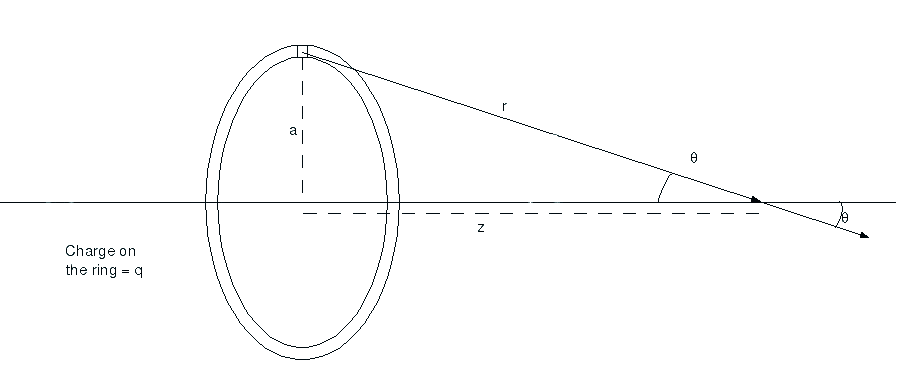
You want to find the field at a point ![]() along the axis from the ring of total charge
along the axis from the ring of total charge ![]() and radius
and radius ![]() . The little square section at the top, that’s the bit that you assume is a charged sphere. Now we don’t know how much charge is in that little section as you can make it any size you want so we just call the charge
. The little square section at the top, that’s the bit that you assume is a charged sphere. Now we don’t know how much charge is in that little section as you can make it any size you want so we just call the charge ![]() , a small amount of
, a small amount of ![]() . So we now have
. So we now have
![]()
Now if you think about it, every bit of the ring above the axis pushing down will have an equal bit below the axis pushing up. It’ll also be the same for left and right and all other parts of the ring. So all the force from the ring will only be acting along the axis. To work out only this bit we need to use some trig. We need to times the field by ![]() to get the axial component.
to get the axial component.
![]()
As you may or may not know ![]() can also be described (using SOH CAH TOA) by the following relationship for our situation
can also be described (using SOH CAH TOA) by the following relationship for our situation
![]()
As ![]() is the adjacent side and
is the adjacent side and ![]() is the hypotenuse. So now we have
is the hypotenuse. So now we have
![]()
However we may not know what ![]() is. We do know the radius of the disk,
is. We do know the radius of the disk, ![]() , and the distance we are from the disk,
, and the distance we are from the disk, ![]() . Using a bit of the old Pythagoras we can rewrite
. Using a bit of the old Pythagoras we can rewrite ![]() in terms of
in terms of ![]() and
and ![]()
![]()
So now our equation looks like this
![]()
Now we want to get rid of that ![]() , so we integrate
, so we integrate
![]()
Now we know from the diagram at the start that the total charge on the disk is ![]() , so if we add up all the little bits of
, so if we add up all the little bits of ![]() the total should be
the total should be ![]() , so the integral is just
, so the integral is just ![]() .
.
![]()
So there you have it, the ![]() field from a charged disk. All you need is the field from a point and some trig knowledge and you can work it out. I could have just given you the final solution, but this way you can see where it came from and then if you forget it you may be able to work it out from first principles like above.
field from a charged disk. All you need is the field from a point and some trig knowledge and you can work it out. I could have just given you the final solution, but this way you can see where it came from and then if you forget it you may be able to work it out from first principles like above.
Gauss’ Law for Magnetism
This one is nice and easy but has some big implications. Gauss’ Law for Magnetism is
![]()
Its like the ordinary gauss’ law in that it describes a field, this time its the magnetic field, ![]() . It says that the integral of B over a closed surface,
. It says that the integral of B over a closed surface, ![]() is zero. Nothing. Every field line that goes out of the surface has an equivalent that goes in. There is no overall field. This means that its impossible to get sources of Magnetic field. Whereas electrons and protons are origins of field, from which field lines diverge from or converge to, there is no magnetic analogue. Magnetic field lines are always closed loops, no start, no end. This of course hasn’t stopped people from preparing in case we do find a magnetic monopole.
is zero. Nothing. Every field line that goes out of the surface has an equivalent that goes in. There is no overall field. This means that its impossible to get sources of Magnetic field. Whereas electrons and protons are origins of field, from which field lines diverge from or converge to, there is no magnetic analogue. Magnetic field lines are always closed loops, no start, no end. This of course hasn’t stopped people from preparing in case we do find a magnetic monopole.
This equation may seem nice, and it is, but it is utterly useless on its own. Usually a 0 result in physics is quite important, it means something special might be happening, here it shows magnetic monopoles don’t exist.
Faradays Law
Now things are getting more complex, here we have Faradays law,
![]()
I’ll walk you through each bit to show you what it actually means. First we have the left hand side which is easy. Its just like Gauss’ law only the integral is over a different thing. Instead of finding the total ![]() field through a surface,
field through a surface, ![]() , we are now finding the total
, we are now finding the total ![]() field around a closed loop
field around a closed loop ![]() . That’s all that’s different with the left hand side, no more surfaces, just closed loops. Now on to the right hand side. First up we have a minus, noting complicated about that. Why its there will be explained later. Next we have another integral, and this one looks horrible. The
. That’s all that’s different with the left hand side, no more surfaces, just closed loops. Now on to the right hand side. First up we have a minus, noting complicated about that. Why its there will be explained later. Next we have another integral, and this one looks horrible. The ![]() symbol basically means a small change. So
symbol basically means a small change. So ![]() is a change in
is a change in ![]() , and
, and ![]() is a change in
is a change in ![]() , where
, where ![]() is time. The whole
is time. The whole ![]() is the rate of change of
is the rate of change of ![]() , its how much
, its how much ![]() is changing (
is changing (![]() ) in a given time (
) in a given time (![]() ). And that is being integrated over an area
). And that is being integrated over an area ![]() .
. ![]() is the area inside the closed loop
is the area inside the closed loop ![]() , if you draw some random squiggly thing making sure that the line doesn’t cross itself and that it joins itself then the length around the line is your
, if you draw some random squiggly thing making sure that the line doesn’t cross itself and that it joins itself then the length around the line is your ![]() and the area inside the line is your
and the area inside the line is your ![]() . Simple yes? So the total
. Simple yes? So the total ![]() around a loop is just equal to the minus of the changing
around a loop is just equal to the minus of the changing ![]() through the loop.
through the loop.
What happens if there is no ![]() ? Well there is no
? Well there is no ![]() so
so ![]() is zero, which makes the integral 0, so no
is zero, which makes the integral 0, so no ![]() . What happens if you have a constant
. What happens if you have a constant ![]() ? Well again
? Well again ![]() is 0. So
is 0. So ![]() is zero, which makes the integral 0, so again no
is zero, which makes the integral 0, so again no ![]() . You can only induce an
. You can only induce an ![]() field from a changing
field from a changing ![]() field.
field.
The importance of the minus sign comes from the fact that ![]() fields create
fields create ![]() fields and
fields and ![]() fields create
fields create ![]() fields (As shown in Faraday’s and Ampere’s Laws). If the minus wasn’t there then the fields would just keep building and building eventually giving infinite energy, and that is not allowed!
fields (As shown in Faraday’s and Ampere’s Laws). If the minus wasn’t there then the fields would just keep building and building eventually giving infinite energy, and that is not allowed!
Ampère-Maxwell Law
The last of Maxwell’s Equations is the Ampere-Maxwell law. Just like the first two laws were similar so are the last two, there is a pattern to them in this order that can make them easier to remember. ![]() over an area,
over an area, ![]() over an area,
over an area, ![]() around a loop and now finally
around a loop and now finally ![]() around a loop. The equation is
around a loop. The equation is
![]()
Left hand side, easy, integral of B around a closed loop. Right hand side, not so easy. First lets ignore the ![]() bit, I’ll come back to that. Other than the
bit, I’ll come back to that. Other than the ![]() , its very similar to Faradays law. You have another changing field integrated over an area, but this time its
, its very similar to Faradays law. You have another changing field integrated over an area, but this time its ![]() . This time though instead of multiplying by minus 1 you’re multiplying by
. This time though instead of multiplying by minus 1 you’re multiplying by ![]() . Once again these are two very important values in physics, alone and combined. They are at the very heart of EM. So your magnetic field around a loop is just equal to the changing E field going through it times by
. Once again these are two very important values in physics, alone and combined. They are at the very heart of EM. So your magnetic field around a loop is just equal to the changing E field going through it times by ![]() , but then you have to add on a bit. This is the
, but then you have to add on a bit. This is the ![]() bit. This is just the current going round the loop times by
bit. This is just the current going round the loop times by ![]() , this is because, as said in Stuff Moving, if you have a moving charge i.e. a current, then you get a magnetic field. So you have to add the two bits together. There, done.
, this is because, as said in Stuff Moving, if you have a moving charge i.e. a current, then you get a magnetic field. So you have to add the two bits together. There, done.
Another Form of the Deep End
As well as writing Maxwell’s equations above, in what is called integral form, you can also write them in differential form like so
![]()
![]()
![]()
![]()
Yet Another Form of the Deep End
Writing Maxwell’s equations in one of the above two forms is really a simplification. Both the integral form and the differential form are vector equations and they save you having to write out the full 8 Maxwell equations for the ![]() and
and ![]() fields in all three dimensions.
fields in all three dimensions.
[su_spoiler title=”8 ‘Original’ Maxwell Equations” style=”fancy”]
![]()
![]()
![]()
![]()
![]()
![]()
![]()
![]()
[/su_spoiler]
Well iot turns out you can also compactify the four vector Maxwell equations into two tensor equations like so
![]()
![]()
Here ![]() is a vector with four components, sometimes called the 4-current, and
is a vector with four components, sometimes called the 4-current, and ![]() is a 4×4 matrix called the electromagnetic tensor. They are defined as
is a 4×4 matrix called the electromagnetic tensor. They are defined as
(6) 
(7) 
where ![]() is the speed of light. The
is the speed of light. The ![]() and
and ![]() just tell you where in the vector or matrix to look, but confusingly for some start at 0, so
just tell you where in the vector or matrix to look, but confusingly for some start at 0, so ![]() and
and ![]() (not to be confused with
(not to be confused with ![]() cubed). Same with
cubed). Same with ![]() , so
, so ![]() and
and ![]()